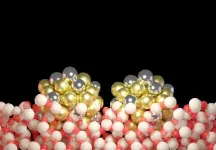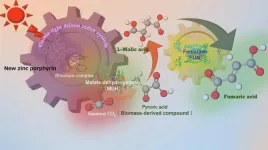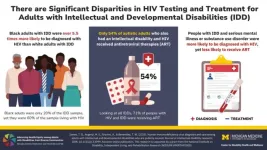(Press-News.org)
GEN Biotechnology announces the publication of its February 2024 issue. GEN Biotechnology publishes outstanding peer-reviewed research and perspectives in all aspects of biotechnology. The Journal, led by Editor-in-Chief Hana El-Samad, PhD (UCSF; Altos Labs) and Executive Editor Kevin Davies, PhD, is published bimonthly in print and online.
For full-text copies of articles or to arrange interviews with Dr. El-Samad, Dr. Davies, authors, or members of the editorial board, contact Kathryn Ryan at the Publisher.
1. Original Research: Fluorescent Sex-Sorting Technique for Pest Control
Genetic biocontrol methods are sustainable alternatives to traditional insecticide-based approaches for controlling pest and disease vector populations. Sterile insect technique (SIT) is a genetic biocontrol technology that suppresses populations through frequent release of sterile males, as female insects are often responsible for destroying agricultural resources or pathogen transmission. In this cover article, Omar Akbari and colleagues from the University of California, San Diego describe a genetically stable sex-sorting technique termed SEPARATOR (Sexing Element Produced by Alternative RNA-splicing of A Transgenic Observable Reporter) to address the need for rapid and accurate sex-sorting technologies. SEPARATOR uses dominantly expressed fluorescent proteins and differentially spliced introns to ensure sex-specific expression. The authors present proof of concept in Drosophila melanogaster. They also suggest that SEPARATOR has potential to be adaptable in various insect species and can enable the study of sex-specific developmental processes.
Contact: Omar Akbari (UCSD)
2. Editorial: The Next Emergence of Synthetic Biology
From the birth of recombinant DNA to today’s CRISPR systems, synthetic biology – the ability to build circuits that interface with cells, tissues, and organisms, to engineer new functions – is one of the foundational pillars of modern biotechnology. While the original synthetic circuits were composed of two to three genes, decades of advancement have only been able to achieve circuits with dozens of genes. In this editorial, Editor-in-Chief, Hana El-Samad, describes the current bottlenecks keeping today’s circuits at the “few dozen” ceiling and presents a new wave of “non-reductionist” synthetic biology.
Contact: Hana El-Samad (Altos Labs, Editor-in-Chief of GEN Biotechnology)
3. An Interview with Peter Marks, Director of CBER at the FDA
In December 2023, the U.S. Food and Drug Administration (FDA) approved two milestone treatments, Casgevy and Lyfgenia, representing the first cell-based gene therapies for the treatment of sickle cell disease in patients 12 years and older. In this interview, Peter Marks, the director of the Center for Biologics Evaluation and Research (CBER) at the FDA, discusses the new wave of advances in cell and gene therapy research and development, and how CBER provides regulatory guidance to ensure that approved products meet stringent criteria of quality, safety, and efficacy. This interview was streamed as the opening keynote session for GEN’s January 2024 virtual summit, The State of Cell and Gene Therapy.
Contact: Alex Philippidis (GEN)
4. Addressing Scientific Misconduct: An Interview with Elisabeth Bik
Elisabeth Bik is a microbiologist and scientific integrity consultant who routinely covers cases of falsified data, plagiarism, and manipulated images on her blog Science Integrity Digest. In this exclusive interview with Uduak Thomas, senior editor at GEN, Bik discusses examples of scientific misconduct, allegations of questionable research practices, and new approaches aimed at reducing instances of misconduct and fraud in scientific literature.
Contact: Uduak Thomas (GEN)
5. Obesity, Artificial Intelligence and More: Vijay Pande on 2024 in Biotech
Vijay Pande is a general partner at Andreesen Horowitz (a16z) as well as the founding investor of a16z’s Bio+Health fund. The former Stanford University professor made his name as the chief architect and director of the folding@home computing network, which debuted in 2000. In this interview by GEN senior business editor, Alex Philippidis, Pande discusses his outlook for biotech in 2024, including M&A trends, the success of metabolic drugs, the potential of gene editing therapies, and the development of AI-based treatments.
Contact: Kaustuva Das (Thermal PR)
END
New Issue of GEN Biotechnology
2024-02-16
ELSE PRESS RELEASES FROM THIS DATE:
New chip opens door to AI computing at light speed
2024-02-16
Penn Engineers have developed a new chip that uses light waves, rather than electricity, to perform the complex math essential to training AI. The chip has the potential to radically accelerate the processing speed of computers while also reducing their energy consumption.
The silicon-photonic (SiPh) chip’s design is the first to bring together Benjamin Franklin Medal Laureate and H. Nedwill Ramsey Professor Nader Engheta’s pioneering research in manipulating materials at the nanoscale to perform mathematical computations using light ...
Study shows impact of antidepressants on fetal brain development during pregnancy
2024-02-16
A new study published in Nature Communications provides direct evidence that antidepressant use during pregnancy can impact a child’s brain development and contribute to the risk of mental health disorders later in life.
The study, led by researchers at the University of Colorado Anschutz Medical Campus, focused on the effect of fluoxetine, commonly used in medications such as Prozac and Sarafem for treating depression and perinatal depression, on a developing prefrontal cortex.
Since fluoxetine works by increasing the levels of serotonin in the brain, the researchers looked at the impact serotonin has on prefrontal ...
First human trial shows ‘wonder’ material can be developed safely
2024-02-16
A revolutionary nanomaterial with huge potential to tackle multiple global challenges could be developed further without acute risk to human health, research suggests.
Carefully controlled inhalation of a specific type of graphene – the world’s thinnest, super strong and super flexible material – has no short-term adverse effects on lung or cardiovascular function, the study shows.
The first controlled exposure clinical trial in people was carried out using thin, ultra-pure ...
Towards more efficient catalysts
2024-02-16
Researchers from the Harvard John A. Paulson School of Engineering and Applied Sciences (SEAS), Harvard Department of Chemistry & Chemical Biology, and Utrecht University have reported on a previously elusive way to improve the selectivity of catalytic reactions, adding a new method of increasing the efficacy of catalysts for a potentially wide range of applications in various industries including pharmaceuticals, cosmetics and much more.
The research is published in ...
Laboratory study on conditions for spontaneous excitation of "chorus emission," wave of space plasma
2024-02-16
A dipole magnetic field, created by a ring current, is the most fundamental type of magnetic field that is found both in laboratories and in space. Planetary magnetospheres, such as Jupiter's, effectively confine plasma. The RT-1 project aims to learn from nature and create a magnetosphere-type high-performance plasma to realize advanced fusion energy. Simultaneously, the artificial magnetosphere offers a means to experimentally understand the mechanisms of natural phenomena in a simplified and controlled ...
Advanced artificial photosynthesis catalyst uses CO2 more efficiently to create biodegradable plastics
2024-02-16
Amid growing global concern over climate change and plastic pollution, researchers at Osaka Metropolitan University are making great strides in the sustainable production of fumaric acid – a component of biodegradable plastics such as polybutylene succinate, which is commonly used for food packaging. The researchers have managed to efficiently produce fumaric acid, which is traditionally derived from petroleum, using renewable resources, carbon dioxide, and biomass-derived compounds.
In a previous study, a research team led by Professor Yutaka Amao of the Research Center for Artificial Photosynthesis at ...
Mystery solved: the oldest fossil reptile from the alps is an historical forgery
2024-02-16
A 280-million-year-old fossil that has baffled researchers for decades has been shown to be, in part, a forgery following new examination of the remnants.
The discovery has led the team led by Dr Valentina Rossi of University College Cork, Ireland (UCC) to urge caution in how the fossil is used in future research.
Tridentinosaurus antiquus was discovered in the Italian alps in 1931 and was thought to be an important specimen for understanding early reptile evolution.
Its body outline, appearing dark against the surrounding rock, was initially interpreted ...
The ties that bind
2024-02-15
Trace metals are nutrient elements, like zinc, that animals and plants need in small amounts to function properly. Animals generally get trace metals in their diets or through environmental exposures, while plants take their trace minerals up from soil. If we get too little, we may experience a deficiency, but the opposite can also be true: too much of a trace metal can be toxic.
Scientists believe that up to 50% of the trace metals in soils and urban environments may be bound to the surfaces of mineral grains — rendering the trace metals ...
New GSA publication addresses dementia care in adults with I/DD
2024-02-15
Addressing Brain Health in Adults With Intellectual Disabilities and Developmental Disabilities: A Companion to the KAER Toolkit for Primary Care Providers is a new publication from the Gerontological Society of America (GSA) designed to address the needs of adults with intellectual and developmental disabilities (I/DD) who develop dementia.
Freely available at geron.org/brainhealth, this companion document:
Raises awareness of unique needs of adults living with I/DD.
Equips and encourages caregivers and health care teams to engage in ...
Inequities in HIV testing, diagnosis and care for people with intellectual and developmental disabilities
2024-02-15
People with disabilities are often at higher risk for exposure to HIV due to barriers in engaging healthcare and other systemic factors and are thus considered a priority for prevention and testing efforts. However, these efforts don’t always extend to people with intellectual disabilities due to the perception that people with intellectual disabilities are mostly asexual.
Researchers at University of Michigan Health conducted one of the largest epidemiological studies of individuals with intellectual and developmental disabilities to closely examine where the gaps in HIV care lie and found large disparities in care for Black patients as well as for patients ...





